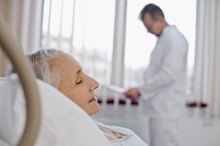Abdominal Pain After Colonoscopy
Many people report feeling pain after having a colonoscopy 6. Most of the time, the discomfort is mild, harmless and very short-lived. Every once in a while, though, abdominal pain might indicate a serious complication, one that may even be life-threatening. If you experience persistent pain after a colonoscopy — particularly pain that grows worse rather than better — get medical help, advises an article in the journal Gastroenterology. Here are some reasons you may feel abdominal pain after a colonoscopy 26.
Trapped Gas
Gassiness is one of the most common aftereffects of a colonoscopy — and yes, it can cause abdominal pain (though usually not serious pain) 6. A standard colonoscopy involves looking at the rectum and large intestine through a tiny video camera attached to a flexible tube called a colonoscope. In order to make it easier for the colonoscope to explore the colon and relay clear images back to the doctor, he or she will insert air into the colon through the rectum. At the end of the exam, this air is suctioned out, but there may still be some left inside, says John H. Ashcraft, DO, chief of colon and rectal surgery at the University of Kansas Medical Center in Kansas City 5. That leftover air can be painful. The best way to get rid of it — and any pain and cramping that goes along with it — is to walk around as soon as you’re able, says Dr. Ashcraft. Eating will also help you expel gas, as can an over-the-counter anti-flatulence drug called simethicone.
- Gassiness is one of the most common aftereffects of a colonoscopy — and yes, it can cause abdominal pain (though usually not serious pain) 6.
Perforation of the Colon
Air Pocket After a Colonoscopy
Learn More
In relatively rare cases, the colonoscope can perforate your intestinal wall as it moves through your colon, allowing air — and possibly some of the contents of your bowel — to pass into your abdominal cavity. “That’s the scary [complication] we worry most about,” says Dr. Ashcraft. “It can happen in anywhere from one in 1,000 to one in 2,000 procedures,” and when it does, “it’s not the typical pain. It’s a lot more severe.” Usually your doctor will know right away that there’s been a perforation, says Dr. Ashcraft, and you’ll be referred for evaluation by a surgeon. Every once in a while, however, the pain resulting from a perforation won’t show up for a day or two, in which case you should contact your doctor immediately.
Certain people are at a higher risk of experiencing a perforation — for example, those whose colons are tight or have difficult angles for the scope to negotiate. “We watch [those] patients more carefully,” says Dr. Ashcraft. Sometimes the colonoscope will tear just the inner lining of your colon, without going all the way through the abdominal wall. This is different from a perforation and not as serious, says Dr. Ashcraft.
- In relatively rare cases, the colonoscope can perforate your intestinal wall as it moves through your colon, allowing air — and possibly some of the contents of your bowel — to pass into your abdominal cavity.
- “ Usually your doctor will know right away that there’s been a perforation, says Dr. Ashcraft, and you’ll be referred for evaluation by a surgeon.
Post-Polypectomy Syndrome
During a colonoscopy, your doctor may not only find small precancerous growths called polyps, but also remove them. Doctors often use heat to get rid of polyps, and if that heat penetrates too deeply, it could cause pain as well as fever. This is called post-polypectomy syndrome 4. “About four to five days after the colonoscopy, you’ll come in presenting with pain and maybe even bleeding,” says Dr. Ashcraft 6. “People [in that situation] will be placed on antibiotics and watched. There may possibly be surgery down the line.”
- During a colonoscopy, your doctor may not only find small precancerous growths called polyps, but also remove them.
- Doctors often use heat to get rid of polyps, and if that heat penetrates too deeply, it could cause pain as well as fever.
Injuries to the Spleen
Blocked Duodenum Symptoms
Learn More
The colon is attached to the spleen, and a colonoscope can sometimes tear this organ. Colonoscopy-induced injuries to the spleen are exceedingly rare, however, according to an article published in the Journal of Surgical Case Reports 7. Pain — especially pain in the left upper abdomen — is one sign that a spleen injury has occurred. Others are bleeding, a fast heartbeat, dizziness and fainting, says Dr. Ashcraft. If you experience any of these symptoms after having a colonoscopy, seek emergency treatment immediately.
- The colon is attached to the spleen, and a colonoscope can sometimes tear this organ.
Related Articles
References
- Gastrointestinal Endoscopy: "Complications of Colonoscopy."
- American College of Gastroenterology: “Colonoscopy FAQs.”
- Journal of Clinical Nursing: "Severity and Duration of Pain After Colonoscopy and Gastroscopy: A Cohort Study."
- American Journal of Gastroenterology: “Post-polypectomy Syndrome.”
- John H. Ashcraft, DO, chief of colon and rectal surgery, University of Kansas Medical Center, Kansas City.
- Gastroenterology: “Abdominal Pain After Colonoscopy.”
- Journal of Surgical Case Reports: "Splenic injury following elective colonoscopy: a rare complication."
- Ranasinghe I, Parzynski CS, Searfoss R, et al. Differences in Colonoscopy Quality Among Facilities: Development of a Post-Colonoscopy Risk-Standardized Rate of Unplanned Hospital Visits. Gastroenterology. 2016;150(1):103-13. doi:10.1053/j.gastro.2015.09.009
- American Cancer Society. Key Statistics for Colorectal Cancer. Updated February 21, 2018.
- Ko CW, Riffle S, Michaels L, et al. Serious complications within 30 days of screening and surveillance colonoscopy are uncommon. Clin Gastroenterol Hepatol. 2010;8(2):166–173. doi:10.1016/j.cgh.2009.10.007
- Mamula P, Adler DG, Conway JD, et al. Colonoscopy preparation. Gastrointest Endosc. 2009;69(7):1201-9. doi:10.1016/j.gie.2009.01.035
- Arora G, Mannalithara A, Singh G, Gerson LB, Triadafilopoulos G. Risk of perforation from a colonoscopy in adults: a large population-based study. Gastrointest Endosc. 2009;69(3 Pt 2):654-64. doi:10.1016/j.gie.2008.09.008
- American Cancer Society. Colorectal Cancer Facts & Figures 2017-2019. Atlanta: American Cancer Society; 2017.
- Reumkens A, Rondagh EJ, Bakker CM, Winkens B, Masclee AA, Sanduleanu S. Post-Colonoscopy Complications: A Systematic Review, Time Trends, and Meta-Analysis of Population-Based Studies. Am J Gastroenterol. 2016;111(8):1092-101. doi:10.1038/ajg.2016.234
- Jehangir A, Bennett KM, Rettew AC, Fadahunsi O, Shaikh B, Donato A. Post-polypectomy electrocoagulation syndrome: a rare cause of acute abdominal pain. J Community Hosp Intern Med Perspect. 2015;5(5):29147. doi:10.3402/jchimp.v5.29147
- Amornyotin S. Sedation-related complications in gastrointestinal endoscopy. World J Gastrointest Endosc. 2013;5(11):527–533. doi:10.4253/wjge.v5.i11.527
Writer Bio
C. Richard Patterson is a retired surgeon and chief medical officer with special interest and experience in gastrointestinal, breast, cancer and trauma surgery. He is the author or co-author of 17 scientific publications, including textbook chapters.








